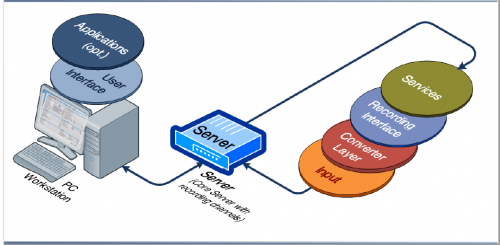NICE (NASDAQ: NICE) is the worldwide leading provider of software solutions that enable organizations to take the next best action to improve customer experience and business results, ensure compliance, fight financial crime, and safeguard people and assets. NICE’s solutions empower organizations to capture, analyze, and apply, in real-time, insights from both structured and unstructured Big Data. This data comes from multiple sources, including phone calls, mobile apps, emails, chat, social media, video, and transactions. NICE solutions are used by over 25,000 organizations in more than 150 countries, including over 80 of the Fortune 100 companies.
System Overview
NICE Trading Recording comes in two configurations:
- Stand Alone Configuration
- Server / Satellite Configuration
Stand Alone

A Stand-Alone deployment consists of a Server, on which the Main Service, the Archive Service, the Database Service and the Web Service run. It has a maximum of 200 recording channels. Calls are stored as audio files on the hard disk. Call information is stored in the database. The web server enables clients to log in. Call information is retrieved from the database and presented on a web page on the client’s computer. Clients can play calls stored on the hard disk. One of the installed services checks at regular intervals for calls to archive, following predefined rules. These calls are saved to the archiving medium, together with the call information from the database.
Server / Satellite

A Core Server is a Server without recording channels, which processes information from satellites and offers it to the clients. A recording system has one Core Server. For resiliency purposes, a second (standby) Core Server can be added. The channels are accommodated by dedicated systems: satellites. Satellites record calls and call information and send them to the Core Server. The number of satellites that can be attached to the Core Server is theoretically unlimited. The number of satellites (and hence the number of channels) affects the load on the server, both in terms of processor power and in terms of storage capacity
Understanding Recording Methods

Analog/TDM Recording
All recording of analog or digital extensions (TDM) or trunk lines, is based on Parrot-DSC technology. The Parrot-DSC cards are directly connected to the phone devices or the trunk(s) using cabling. The cards convert the different proprietary telecommunications protocols to voice files on NICE Trading Recording.
VoIP Recording
Recording of Voice over IP (VoIP) uses a software module that acts as a Parrot-DSC card. We distinguish:
Passive VoIP Recording
For Passive VoIP recording the system is equipped with configured Network Interface Cards, which receive the data from all connected IP phones within the voice VLAN via a SPAN port.

CTI VoIP Recording
CTI VoIP recording is always integrated with a vendor CTI system (CTI: Computer Telephony Integration). It can be either Passive or Active CTI IP Recording. Active CTI uses the firmware files from the generic cti vox_voip kit. Besides the firmware, this recording method also requires specific integration software.

